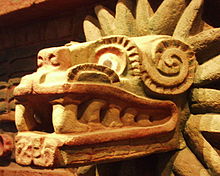- Black Sun (mythology)
-
The Black Sun in Mesoamerican mythology has many mystical meanings, among them it is connected to the god Quetzalcoatl and his penetration in the Underworld through the west door after his diurnal passage on the sky. Amidst the Mexicas there were two suns, the young day sun and the ancient sun, the dark sun. Some scholars regard the mythological black sun as the ancient female origin of all, it is both tomb and womb. This way, it is the oneness that uniformly integrates unawareness, death, and yet an expectation of fecundity. [1]
Contents
Other views
The Aztecs associated the passage of the black sun, on its nightly journey through the underworld, with the image of a butterfly.[2][3] The butterfly, in turn, it is an archetypical symbol of the transcendent soul, transformation and mystical rebirth,[3][4] whereas also seen in the figure of the frightening earth goddess Itzpapalotl, the "Obsidian Butterfly", that devoured people during the solar eclipses,[5] while the Aztec underworld was the eternal dwelling place of the souls. According to the Codex Vaticanus A, the underworld was made of nine layers. The first level was the Earth's surface, which also had the entrance, or the face of a gigantic toad that devoured the dead and gave access to the other eight lower levels. The souls of the dead occupied the ninth level known as "Mictlan Opochcalocan".[6]
The connection with nocturnal elements also it is ascribed to the god Tezcatlipoca, son of the primordial god Ometeotl who was a god of dualities such as light and darkness. Black Tezcatlipoca, as was known, was one of the five suns of the creation myth of some Nahua peoples, he ruled over the north, the Earth, night, sorcery, and judgment.[7] Another study[8] still reports the sun god Uitzilopochtli, which crossed the underworld during the night bestowing light to the forgotten souls, however he demanded human blood as payment to his tasks. Before his nightly effort, Uitzilopochtli (also Huitzilopochtli) was accompanied, from the zenith to his setting, by the Ciuapipiltrins, the souls of women who had died in childbirth, which then reappeared as vespertine moths on Earth.[8]
At archeological scenes the Plumed Serpent shows a man with a black sun within a yellow sun. In this manner the spinning of the sun and black sun shows a wheel crossing with a obfuscatory motion where four black rays move out of four yellow rays.[1] According to some authors, these sets of four rays relate to the four cardinal points and the four quarters, they represent the governance held by the gods of human race since its infancy, as well as the annual rotation of the heavens, and the universal rulership portrayed in the great dance called "Mitotiliztli", which reproduces the appearance of a wheel.[1]
See also
- Black Sun (alchemy)
- Black Sun (occult symbol)
- Five Suns (mythology)
- Lords of the Night (mythology)
- Tzitzimitl (mythology)
Notes
- ^ a b c Dick, Susan; K.D.; M.D.; (1989) pp 165-166.
- ^ Longo, Teresa (2002), pp 187-188.
- ^ a b O'Connell, Mark; R.A., (2005) pp 185.
- ^ H. Resh, Vincent; R.T.C., (2009) pp 239-240.
- ^ Aguilar-Moreno, (2007) pp 149.
- ^ Aguilar-Moreno, (2007) pp 139.
- ^ Olivier, Guilhem , (2003).
- ^ a b Joyce, Thomas Athol, (1920) pp 52, 102, 106.
References
- Aguilar-Moreno, Manuel (2007). Handbook to Life in the Aztec World. Oxford University Press. ISBN 0195330838.
- Dick, Susan; Declan, Kiberd; Dougald, McMillan (1989). Essays for Richard Ellmann: Omnium Gatherum. Mcgill Queens University Press. ISBN 0773507078.
- Joyce, Thomas Athol (1920). Mexican archaeology: an introduction to the archaeology of the Mexican and Mayan civilizations of pre-Spanish America. University of Michigan Library. ASIN B004183HZC.
- Longo, Teresa (2002). Pablo Neruda and the U.S. Culture Industry (Hispanic Issues). Routledge. ISBN 0815333862.
- H. Resh, Vincent; T. Cardé, Ring (2009). Encyclopedia of insects. Academic Press. ISBN 0123741440.
- O'Connell, Mark; Airey, Raje (2005). The illustrated encyclopedia of signs & symbols. Lorenz. ISBN 075481548X.
- Olivier, Guilhem (2003). Mockeries and Metamorphoses of an Aztec God. University Press of Colorado. ISBN 0870817450.
Aztec religion and mythology Aztec religion 
Aztec mythology Centeotl · Chalchiuhtlicue · Cihuacoatl · Coatlicue · Coyolxauhqui · Ehecatl · Huehuecoyotl · Huehueteotl · Huitzilopochtli · Mictlantecuhtli · Mixcoatl · Piltzintecuhtli · Quetzalcoatl · Tepoztecatl · Tezcatlipoca · Tlaloc · Tlazolteotl · Toci · Tonatiuh · Xipe Totec · Xiuhcoatl · Xiuhtecuhtli · Xochipilli · Xochiquetzal · Xolotl ·Places in Aztec myth Underworlds 
Aztec mythology (Mictlan) · Buddhism (Naraka) · Chinese mythology (Diyu) · Persian mythology (Duzakh) · Christianity (Purgatory · Limbo · Hell) · Ancient Egyptian religion (Duat) · Germanic and Norse paganism (Hel · Niflheim) · Greek mythology (Hades · Tartarus) · Hinduism (Naraka · Patala) · Islam (Barzakh · Jahannam) · Jainism (Naraka) · Judaism (Gehenna · Sheol) · Shinto (Yomi) · Turkic-Mongolian (Erlik)
 Categories:
Categories:- Aztec mythology and religion
- Mesoamerican mythology and religion
- Night gods
Wikimedia Foundation. 2010.


